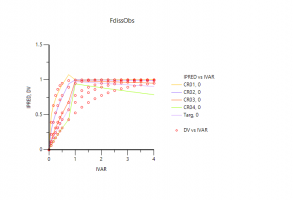Hello everyone,
I am using a very simple custom model to fit some dissolution data.
I plan to fit the data to two different equations:
(1) when time<3, Fdiss=kd*(Time^n)
(2) when time>=3, Fdiss=A^(Time)
I am using the following PML model:
test(){
covariate(Time)
sequence{
if (Time<3){
Fdiss=kd*(Time^n)
} else {
Fdiss=A^(Time)
}
}
error(FdissEps = 1)
observe(FdissObs(Time) = Fdiss+ FdissEps)
fixef(kd = c(, 1, ))
fixef(n = c(, 1, ))
fixef(A = c(, 1, ))
}
However, the following warning message appears: 'Variable 'Fdiss' undefined'
Can anyone help me?
Many thanks in advance
Best regards
Sara














